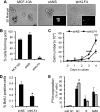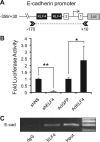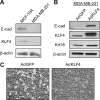Kruppel-like factor 4 inhibits epithelial-to-mesenchymal transition through regulation of E-cadherin gene expression
- PMID: 20356845
- PMCID: PMC2878056
- DOI: 10.1074/jbc.M110.114546
Kruppel-like factor 4 inhibits epithelial-to-mesenchymal transition through regulation of E-cadherin gene expression
Abstract
The Krüppel-like factor 4 (KLF4) is a transcriptional regulator of proliferation and differentiation in epithelial cells, both during development and tumorigenesis. Although KLF4 functions as a tumor suppressor in several tissues, including the colon, the role of KLF4 in breast cancer is less clear. Here, we show that KLF4 is necessary for maintenance of the epithelial phenotype in non-transformed MCF-10A mammary epithelial cells. KLF4 silencing led to alterations in epithelial cell morphology and migration, indicative of an epithelial-to-mesenchymal transition. Consistent with these changes, decreased levels of KLF4 also resulted in the loss of E-cadherin protein and mRNA. Promoter/reporter analyses revealed decreased E-cadherin promoter activity with KLF4 silencing, while chromatin immunoprecipitation identified endogenous KLF4 binding to the GC-rich/E-box region of this promoter. Furthermore, forced expression of KLF4 in the highly metastatic MDA-MB-231 breast tumor cell line was sufficient to restore E-cadherin expression and suppress migration and invasion. These findings identify E-cadherin as a novel transcriptional target of KLF4. The clear requirement for KLF4 to maintain E-cadherin expression and prevent epithelial-to-mesenchymal transition in mammary epithelial cells supports a metastasis suppressive role for KLF4 in breast cancer.
Figures






Similar articles
-
Nuclear factor I-C regulates E-cadherin via control of KLF4 in breast cancer.BMC Cancer. 2015 Mar 10;15:113. doi: 10.1186/s12885-015-1118-z. BMC Cancer. 2015. PMID: 25879941 Free PMC article.
-
Krüppel-Like Factor 4 Inhibits Pancreatic Cancer Epithelial-to-Mesenchymal Transition and Metastasis by Down-Regulating Caveolin-1 Expression.Cell Physiol Biochem. 2018;46(1):238-252. doi: 10.1159/000488426. Epub 2018 Mar 21. Cell Physiol Biochem. 2018. PMID: 29587259
-
Krüppel-like factor 4 inhibits tumorigenic progression and metastasis in a mouse model of breast cancer.Neoplasia. 2011 Jul;13(7):601-10. doi: 10.1593/neo.11260. Neoplasia. 2011. PMID: 21750654 Free PMC article.
-
KLF4: a multifunctional nexus connecting tumor progression and immune regulation.Front Immunol. 2025 Feb 6;16:1514780. doi: 10.3389/fimmu.2025.1514780. eCollection 2025. Front Immunol. 2025. PMID: 39995670 Free PMC article. Review.
-
The diverse functions of Krüppel-like factors 4 and 5 in epithelial biology and pathobiology.Bioessays. 2007 Jun;29(6):549-57. doi: 10.1002/bies.20581. Bioessays. 2007. PMID: 17508399 Free PMC article. Review.
Cited by
-
Unraveling the Molecular Puzzle: Exploring Gene Networks across Diverse EMT Status of Cell Lines.Int J Mol Sci. 2023 Aug 14;24(16):12784. doi: 10.3390/ijms241612784. Int J Mol Sci. 2023. PMID: 37628965 Free PMC article. Review.
-
Differential Expression of miRNAs in Hypoxia ("HypoxamiRs") in Three Canine High-Grade Glioma Cell Lines.Front Vet Sci. 2020 Feb 28;7:104. doi: 10.3389/fvets.2020.00104. eCollection 2020. Front Vet Sci. 2020. PMID: 32258065 Free PMC article.
-
Klf4 reduces stemness phenotype, triggers mesenchymal-epithelial transition (MET)-like molecular changes, and prevents tumor progression in nasopharygeal carcinoma.Oncotarget. 2017 Sep 27;8(55):93924-93941. doi: 10.18632/oncotarget.21370. eCollection 2017 Nov 7. Oncotarget. 2017. PMID: 29212199 Free PMC article.
-
Intercellular Communication in Airway Epithelial Cell Regeneration: Potential Roles of Connexins and Pannexins.Int J Mol Sci. 2023 Nov 10;24(22):16160. doi: 10.3390/ijms242216160. Int J Mol Sci. 2023. PMID: 38003349 Free PMC article. Review.
-
Krüppel-like factor 4 induces apoptosis and inhibits tumorigenic progression in SK-BR-3 breast cancer cells.FEBS Open Bio. 2015 Mar 2;5:147-54. doi: 10.1016/j.fob.2015.02.003. eCollection 2015. FEBS Open Bio. 2015. PMID: 25834779 Free PMC article.
References
-
- Segre J. A., Bauer C., Fuchs E. (1999) Nat. Genet. 22, 356–360 - PubMed
Publication types
MeSH terms
Substances
Grants and funding
LinkOut - more resources
Full Text Sources
Other Literature Sources
Medical
Miscellaneous

